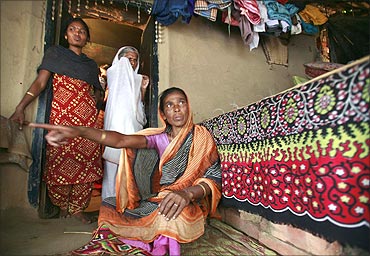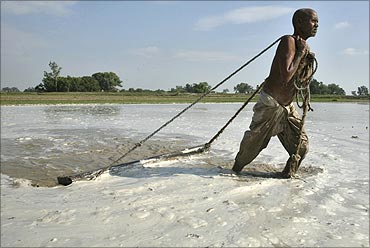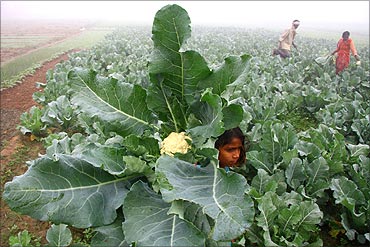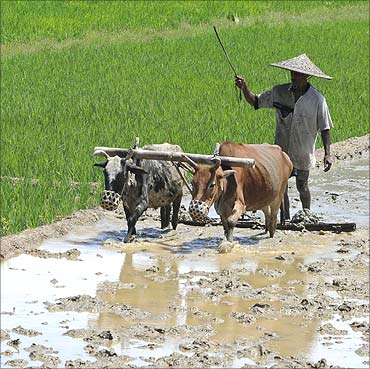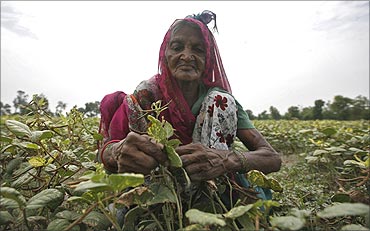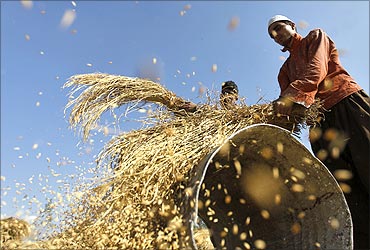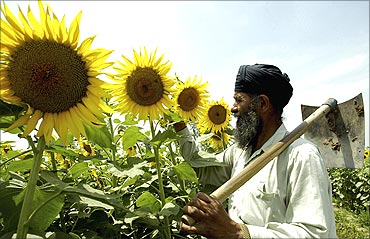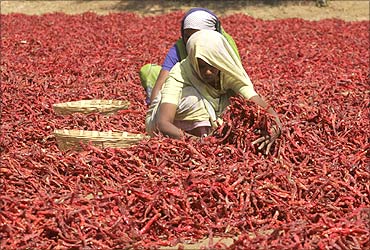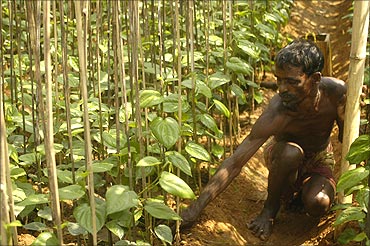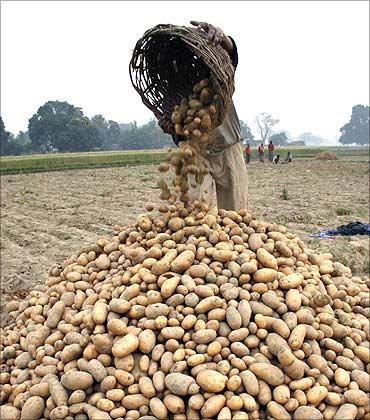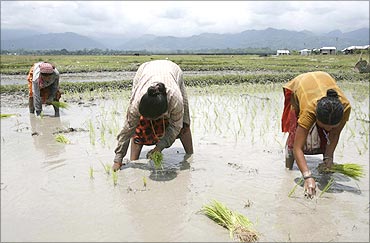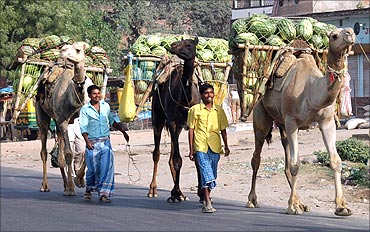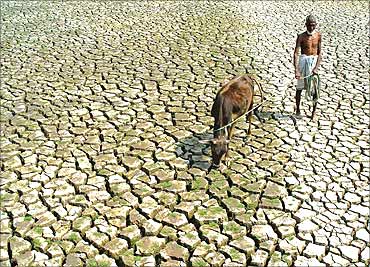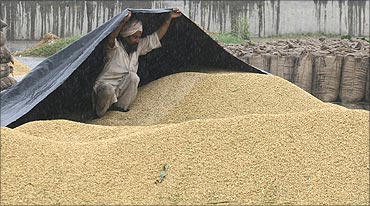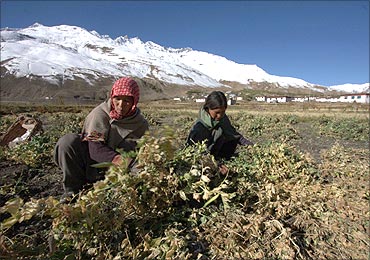This article was first published 14 years ago
Home »
Business » A day in the life of desperate Indian farmers
A day in the life of desperate Indian farmers
Last updated on: January 13, 2011 13:59 IST
Image: Asha Patra's husband committed suicide due to depression
Photographs: Jayanta Shaw/Reuters.
The cold wave has sounded the death knell for farmers in Vidarbha, Maharashtra. Snow and hail wreaked havoc in the cotton belt.
Unable to bear the burden of the crop damage, the debt-ridden cotton farmers who were anxiously waiting to reap the benefits of a robust harvest took the extreme step of ending their lives. Nine farmers in the Vidarbha region have committed suicide in just the last 5 days.
For farmers in India, every day is a fight for survival. Despite toiling hard for long hours, they hardly get the right price for the produce nor do they get timely assistance from the government.
The rising prices hardly offer succour to the farmer as the middlemen and traders mint money buying the produce from farmers at cheap rates. Even as the prices or vegetables and cereals rise to record levels, farmers become poorer.
Living on the mercy of money lenders, many are forced to end their lives. The statistics are alarming -- 17,368 farmers committed suicide in 2009 alone.
Maharashtra saw the largest number of 2,872 suicides.
Click NEXT to see how farmers work hard to feed millions even as they go hungry...
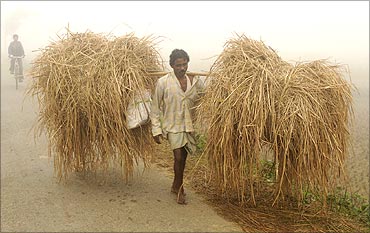
Image: A farmer carries bundles of straw amid dense fog on the outskirts of Agartala, capital of Tripura.
Photographs: Jayanta Dey.
Agriculture contributed around 14.6 per cent of the India's gross domestic product (GDP) in 2009-10.
During 1990-91, Agriculture was a major contributor to the economic growth, accounting for 32 per cent of the GDP.
Image: A farmer pulls a wooden plank to level the soil in a paddy field on the outskirts of the Allahabad.
Photographs: Jitendra Prakash/Reuters.
India ranks second in farm output worldwide. India's agriculture and allied sector grew by 3.8 per cent in the first six months of the current fiscal (2010-11).
According to World Bank, India's large subsidies are hampering productivity-enhancing investment. Besides this, the overregulation of agriculture has increased costs, price risks and uncertainty.
Image: A farmer and his family work at their cauliflower field amid dense fog.
Photographs: Ajay Verma/Reuters.
The total geographical area of India is 328.7 million hectares of which 140.3 million hectares is net sown area, while 193.7 million hectares is the gross cropped area.
Image: A farmer sleeps next to a sugarcane field in the village of Dumchhedi in Punjab.
Photographs: Ajay Verma/Reuters.
India has become the world's largest producer across a range of commodities. The country is expected to see a rise in production in foodgrains, oilseeds, cotton, sugarcane, and fruits and vegetables in 2010-11, but it will hardly bring any respite to the poor farmers.
Image: A farmer ploughs his paddy field in Kadamtala village, about 189 km (117 miles) north of Agartala.
Photographs: Jayanta Dey/Reuters.
Rice, the staple food of India is mainly cultivated in West Bengal, Uttar Pradesh, Madhya Pradesh, Orissa and Bihar.
Image: A farmer works in a pulse farm at Bakrol village on the outskirts Ahmedabad.
Photographs: Amit Dave/Reuters.
Pulses have been cultivated over 11 million hectares in 2010, compared to 9 million hectares in the same period last year. Pulses production in the 2009-10 kharif season was 4.30 million tonnes.
Image: Kashmiri farmers.
Photographs: Reuters.
Kashmiri farmers thresh paddy on a drum during the harvest in Shariefabad on the outskirts of Srinagar.
The private sector investment in agriculture has increased from $14 billion in 2004-05 to $25.5 billion in 2008-09.
Image: Kashmir Singh, 56, a farmer, inspects his sunflower crop in a field at Dharar village.
Photographs: Reuters.
The summer-sown oilseeds output is expected to rise by more than 12 per cent. However, sunflower output is likely to fall to 1.4 million tonnes, adding to the woes of farmers.
Image: Workers spread red chilli peppers to dry in Shertha village on the outskirts of Ahmedabad.
Photographs: Amit Dave/Reuters.
India is the largest producer and consumer of chillies in the world with a contribution of nearly 25 percent of the global output.
The average production in India is expected to be one million tons per year. The total production of chili fell in 2010.
Image: A farmer works in a Paan or betel leaf garden in Sonamura village near Tripura.
Photographs: Jayanta Dey/Reuters.
A bad monsoon had hit betel leaf production in 2009. However, in 2010 its production has risen.
While 66 per cent of the total betel leaf production is from West Bengal, 22 per cent comes from Uttar Pradesh.
Image: A farmer collects potatoes at a farm in Kadohiyar village.
Photographs: Jitendra Prakash/Reuters.
India accounts for nearly 8 per cent of the total global potato production, which is pegged at about 320 million tonnes for the year 2010. The late blight disease has however hit harvest in many states.
Image: Farmers plant rice seedlings in their field on the outskirts of Siliguri.
Photographs: Rupak De Chowdhuri/Reuters.
The area under paddy cultivation has increased by 7.4 per cent to 33.67 million hectares. During the 2009-10 kharif season, the paddy output had dropped by 11 per cent to 75.91 million tonnes from nearly 85 million tonnes in the same period of the previous year.
Image: Farmers transport watermelons on their camels to sell in a market near Allahabad.
Photographs: Jitendra Prakash/Reuters.
India accounts for about 41 percent of world's mangoes and around 23 per cent bananas. India produces 32 million MT of fruits, accounting for about 8 per cent of the world's total fruit production.
Image: A farmer arranges radish at a vegetable market.
Photographs: Amit Gupta/Reuters.
India is the second largest producer of vegetables in the world, after China.
Image: An Indian farmer walks with his hungry cow through a parched paddy field in Agartala.
Photographs: Reuters.
Two-thirds of India's people depend on rural employment for a living.
Image: An Indian farmer sleeps on watermelons in Siliguri.
Photographs: Rupak De Chowduri/Reuters.
As inflation rises to record levels, it's the farmers and the consumers who suffer the most. Unseasonal rains have further worsened the plight of farmers.
Image: A farmer inspects a snow covered cauliflower field with his child near Kufri.
Photographs: Anil Dayal/Reuters.
India produces 4.694 M mt of cauliflower per year from 0.256 M ha area with an average productivity of about 18.3 MT per hectare. The major cauliflower producing states are Bihar, Uttar Pradesh, Orissa, West Bengal, Assam, Haryana and Maharashtra.
Image: A farmer sits besides a heap of paddy as he protects himself with plastic tarpaulin during rains.
Photographs: Ajay Verma/Reuters.
India is the world's second largest producer of white rice, accounting for 80 per cent of the world's rice production.
Image: Tribal women work in a peas field in Lossar village, Himachal Pradesh.
Photographs: Anil Dayal/Reuters.
India's agri-export turnover is expected to rise to nearly $18 billion, according to Agricultural and Processed Food Products Export Development Authority (APEDA).
